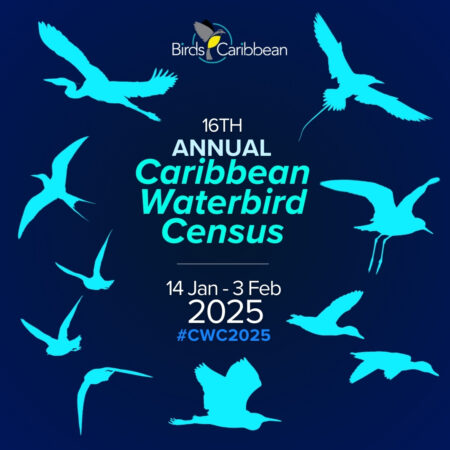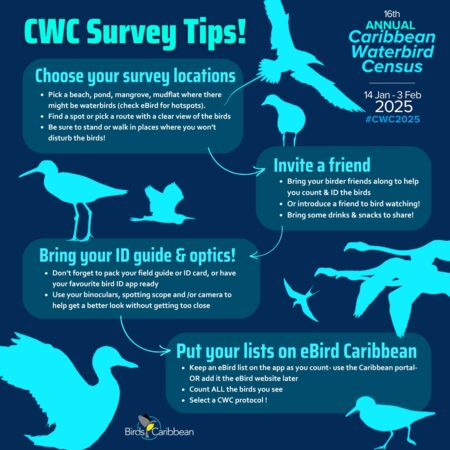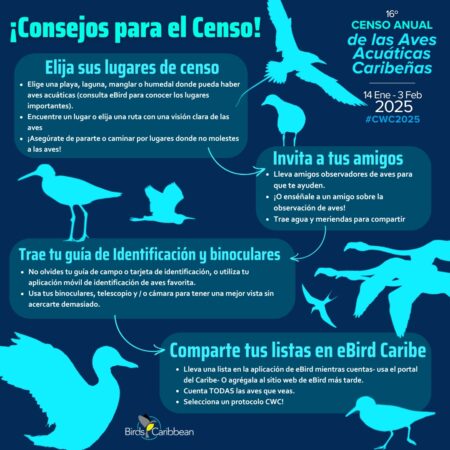 Get ready for the 16th annual Caribbean Waterbird Census (CWC) Region-Wide count! From January 14th to February 3rd 2025, you can make a direct impact on waterbird conservation in the Caribbean. Want to know more? Keep reading to find out everything you need to know about our CWC 2025 regional count.
Get ready for the 16th annual Caribbean Waterbird Census (CWC) Region-Wide count! From January 14th to February 3rd 2025, you can make a direct impact on waterbird conservation in the Caribbean. Want to know more? Keep reading to find out everything you need to know about our CWC 2025 regional count.
The data collected from the past 15 years of the CWC has been invaluable in helping us conserve waterbirds in the region! Your survey efforts can help us identify and protect important places for waterbirds in the Caribbean. For instance the Cargill Salt Ponds in Bonaire were designated a Western Hemisphere Shorebird Reserve Network (WHSRN) site of Regional Importance as a direct result of survey efforts. CWC surveys are also critical in tracking waterbird populations and threats to waterbirds and their wetland homes.
Caribbean wetlands are home to over 185 species of waterbirds making them a treasure to explore and vital to protect. Our wetlands host endemic and globally threatened species, along with many migratory birds. The data you help us collect through this ongoing, standardized survey is crucial for understanding how to conserve these exceptional species and manage their habitats effectively.
Ready, set, count! Get out there and enjoy the waterbirds
Why not wade into the wonderful world of waterbirds? Everyone is welcome to join in with the CWC in 2025! You can do your waterbird counts solo, team up with friends, or even reach out to a local environmental NGO for support and guidance. It’s as easy as heading out to your nearest wetland, and recording all the birds you see.

For the CWC, a wetland is any area where water is the primary factor controlling what lives there. This wide broad definition includes covers coastal wetlands like mangroves, mud flats, lagoons and beaches, as well as inland wetlands like lakes, ponds, swamps, areas around rivers and streams and even some types of agriculture (e.g. rice fields).
Of course, to participate in the Caribbean Waterbird Census, you need to be in the Caribbean when you do your counts! Check out our handy survey tips below to help you get started with your CWC surveys:
You can find detailed information about how to conduct surveys here.
Remember: Use CWC protocols in eBird!

Want to be sure that your counts count? Then use eBird AND chose one of the CWC protocols. Data from the CWC is all stored on eBird Caribbean but to make sure your count is included in the CWC you must use one of the CWC protocols for your list.
Using one of these protocols in eBird is critical, without it we will not know that you have done a CWC count and your data will not be logged in our CWC database.
When you submit your sightings on Step 2, under “Observation Type” be sure to pick one of the CWC options. Simply making an eBird list during the regional count dates is not enough—selecting the appropriate protocol is required for it to be ‘counted’ as CWC data. If you are using the mobile eBird app to collect and submit your data, don’t forget that you need to use the eBird Caribbean portal to see the CWC protocol options (check in your settings). If you’re new to eBird, check out our helpful video here on how to use eBird and Merlin.
Finally, whilst you’ll be on the lookout for waterbirds (ducks, herons, egrets, shorebirds etc.) you should be sure to count all the birds that you see and hear during your survey visits. If you need help with eBird submissions, have questions about which CWC protocol to choose, or with setting up an eBird account, please contact Alex Sansom: waterbird.manager@birdscaribbean.org
We’re here to help!
New to the CWC survey or need a refresher? Don’t worry! We’ve put together amazing resources that will make your counts easy, enjoyable and successful. To help you get started or refresh your memory, watch our YouTube webinar that walks you through the CWC survey steps!
What’s that? You need a hand with your waterbird ID? You’ve come to the right place—brush up on your ID skills using our videos on YouTube!
Part I covers herons, egrets, ducks, marsh birds, and seabirds.
Part II tackles those tricky shorebirds!
We also have even more ID, survey planning tips, and outreach resources that are available for you to use and download on this page. This includes information on what to do if you see a banded bird during your surveys as well as our handy ID Guide to Common Caribbean Shorebirds, which can print and take with you on your surveys.
If you need more help with those troublesome shorebirds you can also check out our series of short videos. Each of these deals with ID-ing some of the shorebirds that are more difficult separate, like Lesser and Greater Yellowlegs and Peeps!
Have fun out there!
We hope you have a great time exploring your country’s wetlands and counting birds during the regional CWC count. Remember every count completed helps protect waterbirds! Please stay safe and carry out your counts responsibly. This means taking care not to disturb the birds or damage their habitats. See how many of your local wetlands you can visit during this three-week period and make an even greater impact on waterbird conservation.
If you find yourself having a fab time with your CWC counts and want to spot more waterbirds, the fun doesn’t stop at the regional count! You can do a CWC survey at any time of the year—just head to a Caribbean wetland and count all the birds you see!

Good luck! We look forward to hearing about your findings. If you need help with bird ID, or have photos and exciting observations to share, please post to our Waterbird Group Listserv (everyone is welcome to join) and/or on our BirdsCaribbean Facebook page. For sharing on social media, use hashtags: #CaribbeanWaterbirdCensus and #WaterbirdsCount AND please tag us: @BirdsCaribbean
Promotional Social Media Graphics – Please feel free to download these graphics and use these to promote your Caribbean Waterbird Census surveys (just open the graphic you want to use right click and choose ‘save image as’) .












